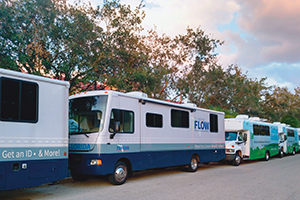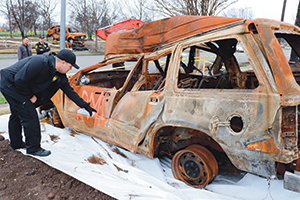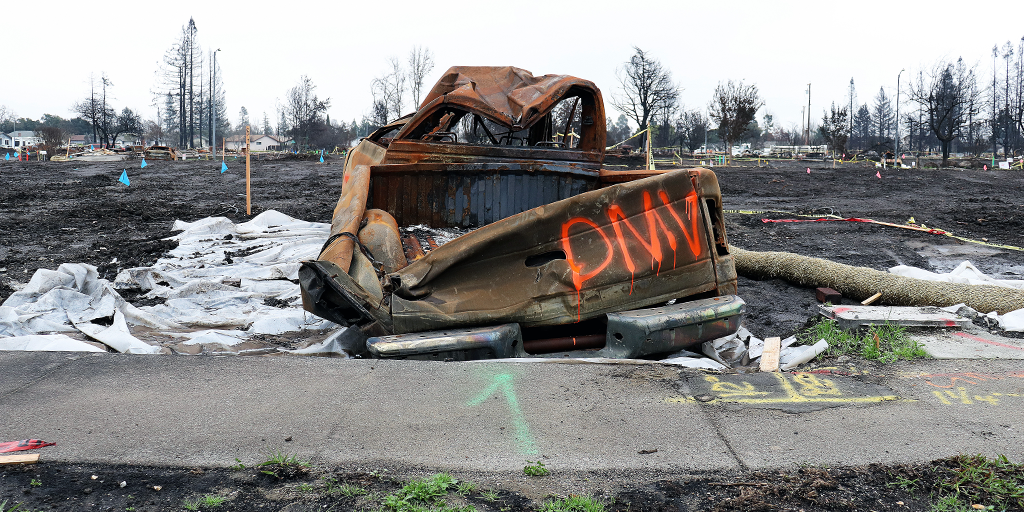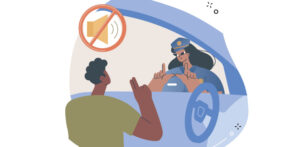Road to Recovery
In times of crisis, AAMVA members deliver safety, security and support
Florida is supposed to be the “Sunshine State.” On Sept. 10, 2017, however, the sun was playing hooky. Where there were supposed to be bright rays of luminescence, instead were ominous clouds full with rain. The culprit: Irma, a Category 4 hurricane that ultimately pummeled Florida with massive storm surges and gale-force winds.
As the storm loomed, authorities issued evacuation orders for 6.3 million Floridians who packed their cars with prized possessions, knowing that Hurricane Irma might raze their homes. Among the rescued belongings: clothing, irreplaceable photos, treasured heirlooms and beloved playthings. What many people forgot to pack, however, was a photo ID.

“If someone is rapidly evacuating, they may forget to take some of their vital documents,” explains Deborah Roby, deputy director of motorist services at the Florida Department of Highway Safety and Motor Vehicles (DHSMV). “You need a driver’s license or state-issued ID card to replace those documents, and to apply for [federal] assistance if there’s damage to your home.”
The importance of identification became even more acute two weeks later, when Hurricane Maria ravaged Puerto Rico. Permanently displaced by the storm, thousands of Puerto Ricans sought refuge in Florida. In order to start a new life there, they needed housing and jobs—neither of which could be obtained without state-issued identification.
It was a stark reminder: DMVs often are just as important in the wake of disasters as first responders; while the latter save lives, the former help rebuild them.
“We’re one of the first steps people take toward making their life a little bit normal again,” Roby says.
It’s an awesome responsibility. To meet it head-on, motor vehicle agencies and their partners should leverage lessons learned in jurisdictions like Florida, California and Texas, each of which was touched by natural disaster in 2017.
Florida: Remote Relief
In the wake of Hurricanes Irma and Maria, DHSMV’s first concern was its employees, with whom it communicated using automated text, email and voice messages.
“We go through an exercise twice a year to make sure our call trees and outreach are actually working,” Roby says. “That’s key, because if your members don’t understand how you’re going to be contacting them and what to expect, they’re not going to respond when they receive those alerts.”
Caring for employees is as important as communicating with them.
“After a storm, you’re trying to provide services to people who need them, but you also have to be cognizant of your members’ needs because they have been impacted, too,” continues Roby, who says DHSMV opened only a limited number of offices after the storms so employees who needed to tend to personal matters could do so. “The public understood, because they were experiencing the same challenges as some of our members.”
Assisting the public was just as important as assisting employees, according to Roby, who says DHSMV deployed four of its 13 mobile units to Orlando and Miami International Airports, where the State Emergency Response Team (SERT) with the Florida Division of Emergency Management (FDEM) had set up disaster relief centers to provide hurricane victims a one-stop shop for government services as they arrived in Florida from Puerto Rico. Operational from October through March, the mobile units were staffed by bilingual examiners who issued state IDs, driver’s licenses and vehicle registrations late into the evening seven days a week—in many cases for free, thanks to an executive order from the governor that temporarily waived select service fees for hurricane victims.
“It was amazing to be there and see all of these government agencies offering their support in one location,” Roby says of the relief centers. “It was an outpouring of human kindness.”
In accordance with the executive order that allowed the department to participate in that outpouring, DHSMV raised the spending limit on mobile employees’ state purchasing cards and temporarily lifted bans on certain purchases. “Normally we can’t buy food or water with our purchasing cards, but we knew we were going to be in areas where people either didn’t have any water or were going to be sitting outside in the heat waiting for services,” Roby says. “So we allowed the purchase of things we normally wouldn’t allow, like coolers filled with bottled water that we could offer to customers who were waiting.”
DHSMV also raised per diems for hotel stays. In Orlando, for example, mobile units hosted employees from South Florida who needed accommodations but faced steep rates due to surging demand.
“If you don’t take care of your members first,” Roby stresses, “they can’t take care of anybody else.”
Texas: Regulations to the Rescue
Before Hurricanes Irma and Maria ripped through Florida and Puerto Rico, respectively, another Category 4 storm—Hurricane Harvey—besieged Houston. To assist victims, the Texas Department of Motor Vehicles leveraged what it believes is the most powerful tool in its tool belt: statute.
Take employees, for example, many of whom had homes or offices—sometimes both—that were flooded and lacking power. “There was no way those employees were going to be able to come into an office,” says Texas DMV Executive Director Whitney Brewster. “So we identified those areas where office closures were occurring and we granted emergency leave so employees did not have to utilize their own leave bank, which we are able to do statutorily.”
Even as it utilized some statutes, the Texas DMV sought relief from others. For example, it asked the governor to temporarily suspend oversize/overweight permitting requirements for commercial vehicles responding to the disaster.
“We are not first responders, but we play an important role in making sure the statutes and regulations we have do not impede the rescue and recovery effort,” explains Brewster, who says statutory relief expedited Houston’s recovery by allowing more vehicles to deliver relief supplies and haul away debris.
The Texas DMV also requested and received relief from vehicle titling and registration requirements in 58 storm-ravaged counties.
“We tried to put ourselves in the shoes of our customers,” Brewster says. “People shouldn’t have to worry about being cited for an expired registration when their house is flooded.”
One law from which the Texas DMV could have sought relief but didn’t was the requirement that it issue new titles for flood-damaged vehicles within five days. “We had the ability to request a waiver from the governor’s office to allow us more time, but we didn’t do that because we knew that the sooner we got flood-damaged vehicles branded, the better it was going to be for the consumer,” explains Brewster, who says the Texas DMV takes seriously its role as a consumer watchdog. To make sure it could quickly process salvage and rebuilt titles—which help consumers identify flood-damaged vehicles when they’re shopping for used cars—the agency ordered additional title paper and toner ahead of the storm and hired 25 temporary employees with the help of a $125,000 grant from AAMVA.
“It’s an ongoing effort because we’re going to be seeing Harvey vehicles in the marketplace for years to come,” continues Brewster, who says the Texas DMV’s current focus is finding permanent instead of temporary statutory opportunities. “What we’re doing now is reviewing our existing statutes in advance of our upcoming legislative session to see if there are any changes that may be necessary for when future disasters arise. Because it’s going to happen again; we just don’t know when.”
California: Feeling the Heat

After Texas, Florida and Puerto Rico faced damage from tremendous amounts of water, California burned, losing 1.4 million acres to wildfires that blazed from October through December 2017.
As they were in Florida, disaster relief centers were a major asset to victims, many of whom turned to the California Department of Motor Vehicles for replacement IDs and driver’s licenses. All told, the California Governor’s Office of Emergency Services (Cal OES) sponsored a total of 17 “local assistance centers” (LACs) during the 2017 wildfires—nine of which were open simultaneously throughout the state.
“We were challenged because we were used to having only one, two or three local assistance centers open at one time,” explains California DMV Director Jean Shiomoto. “We only had portable equipment for eight because we have eight regions. So overnight we had to quickly contact our vendors to acquire extra equipment.”
But the most important ingredient at LACs wasn’t equipment. Rather, it was people.
“One of the things that was critical to our success at these local assistance centers was ensuring that we identified the right staff to go and work at them,” says California DMV Chief Deputy Director Bill Davidson. “We needed staff who were compassionate, who understood the situation and who could be very patient. But we also wanted to make sure that we didn’t burn anyone out, because working at these local assistance centers was very emotionally draining. So we had to ensure that we had enough staff identified and willing to work so that we could rotate people through without having any one person work an inordinate number of hours.”
In order to recover, wildfire victims needed not only identification with which to access relief, but also safe land on which to rebuild their homes. So while some DMV staff manned LACs, investigators worked alongside partners— the U.S. Army Corps of Engineers, the Federal Emergency Management Agency (FEMA) and the California Highway Patrol (CHP), among others—to identify, record and remove more than 4,000 burned vehicles from scorched properties.
“We wanted to prevent fraud so we didn’t have vehicles being cloned in other states,” explains California DMV Investigations Acting Chief Mary Bienko, who says investigators spent six weeks going door to door in search of vehicles, which they identified by cross-referencing visual cues and location data with the DMV’s registration database. Once vehicles were verified, their remains had to be removed with other debris by a licensed salvage company, at which point property owners could submit insurance claims and begin the process of rebuilding.
“There were a lot of challenges, but by working together with all the other agencies that were involved, we were able to get it done,” Bienko says. “Now, families are finally able to move on and start building on their properties.”
Peer support
Finally, motor vehicle administrators should solicit knowledge from those who best understand their challenges and opportunities: their peers.
“Right before Hurricane Harvey hit, I received a call from my counterpart at the Louisiana Office of Motor Vehicles, who was offering us advice and assistance based on her state’s experience with Hurricane Katrina in 2005,” Brewster says. “That’s one of the beautiful things about AAMVA: We’re able to share best practices and learn from each other’s past experiences. That was very, very helpful for me, and we at the Texas DMV stand ready to return the favor by sharing our insights with other states that may be impacted by something similar in the future.”
Ready to Respond?
All communities—and by extension, all motor vehicle agencies—are vulnerable to disasters. Fortunately, there are things your organization can do today to prepare for a crisis tomorrow:
Create policies and procedures
Having a written plan for closing offices and continuing operations creates calm amid chaos. At the Texas DMV, for instance, employees knew exactly what to do as Hurricane Harvey approached; they deposited all the money from the day’s transactions, raised all computers off the floor in case of flooding, and positioned security cameras so they could observe offices remotely.
Build relationships
Disaster response is a team sport. To make sure teams are cohesive, players should get to know one another before game day. In Texas, for example, the Texas DMV found statutory waivers easy to obtain during Harvey because it had already cultivated a strong relationship with the governor’s office. It also had close working relationships with law enforcement, insurance companies and motor carriers, as well as with its sister agency, the Texas Department of Public Safety. When stakeholders know each other, it generates interpersonal capital that can be spent with great effect during a disaster.
Spread the word
Agencies can bring order to disorderly situations by developing in advance a communications plan. In Florida, for example, DHSMV relied on signage at closed DMV offices to direct citizens to the nearest open office; in some cases, it even stationed employees outside to hand out maps and give directions. And in Texas, the Texas DMV shared information via a dedicated webpage, social media, press releases and industry associations like the Texas Trucking Association (TXTA) and the Texas Independent Auto Dealers Association, both of which shared information with their members on the DMV’s behalf.
Rehearse
One way to build relationships with stakeholders is to rehearse with them. In California, for instance, Cal OES regularly organizes tabletop exercises during which partners—including the DMV—verbally practice a statewide response to disasters.
Build a culture of caring
When employees feel cared for, they will care for customers. During Harvey, the Texas DMV organized several fundraisers to raise money for employees impacted by the storm. And in California, DMV administrators visited local assistance centers to personally thank employees working there. California DMV Director Jean Shiomoto sent employees thank-you letters to show her gratitude.




